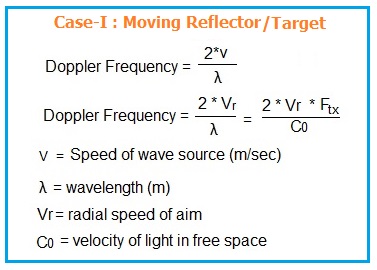

The equation can give negative frequency values, but -500 Hz is pretty much the same as +500 Hz as far as an observer is concerned. When the source moves faster than the wave speed the source outruns the wave. This overlay of all the waves produces a shock wave known as a sonic boom. All the peaks are at the same place, so the wavelength is zero and the frequency is infinite. If the source is traveling at the speed of sound, the waves pile up and move along with the source. Why is this?Īssuming a stationary observer and a source moving at the speed of sound, the Doppler equation predicts an infinite frequency.

Sonic booms occur when the source travels at, or faster than, the speed of sound. The bat detects a 60.1 kHz wave, which it could use to figure out how fast the moth is flying.
#Doppler effect calculation plus#
V O = 20.0 m/s (use the plus sign - moving toward) Once again we use the general Doppler equation, but this time the bat is the observer and the moth acts as the source. V O = 8.00 m/s (use the minus sign - moving away)

What frequency are the waves detected by the bat? (b) The waves reflect off the moth and are detected by the bat. (a) Assuming the moth could detect the waves, what frequency waves would it observe? The bat is traveling at 20.00 m/s toward a moth, which is flying away from the bat at 8.00 m/s. The general equation accounting for any motion is:įor both sets of signs use the first sign when the motion is toward the other thing, and the second sign when the motion is away.Ī particular bat emits ultrasonic waves with a frequency of 56.00 kHz. We can write out a general Doppler equation for the observed frequency by simply combining the previous results. In some situations both the source and the observer move. Use the first sign (-) when the source moves toward the observer, and the second sign (+) when it moves away. When the source moves at speed v s, the wavelength is different by the distance traveled by the source in one period: When nothing moves the wavelength is equal to vT, where T is the period, or v/f, because T = 1/f. This time, though, the shift occurs because the wavelength has been lowered by the movement of the source. What happens when the source of the waves moves toward you, a stationary observer? Again, you encounter more waves per unit time than you did before so the frequency is shifted up. Use the first sign (+) when the observer moves toward the source and the second sign (-) when the observer moves away. In general the observed frequency when the observer moves is: If you moved away from the source the observed frequency is lower. The frequency of the waves you detect is higher, and is given by: Relative to you, the waves travel at a higher speed: You encounter more waves per unit time than you did before. Let's say you, the observer, now move toward the source with velocity v O. V represents the speed of sound through the medium. The usual relationship between frequency, speed, and wavelength is: You are the observer of the sound wave, and you are also stationary. We will focus on sound waves in describing the Doppler effect, but it works for other waves too.Ĭonsider a stationary source of sound broadcasting a single frequency sound wave. A similar effect occurs if the sound source is stationary and you move toward it or away from it. The frequency shifts abruptly to lower than usual when the vehicle passes you and moves away. When the vehicle comes toward you the siren frequency is higher than usual. A good example is when an emergency vehicle passes with its siren going. We've all observed the Doppler effect with our ears. Applications of the Doppler effect range from medical tests using ultrasound to radar detectors and astronomy (with electromagnetic waves). The Doppler effect is the shift in frequency of a wave that occurs when the wave source, or the detector of the wave, is moving.


 0 kommentar(er)
0 kommentar(er)
